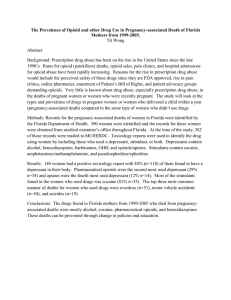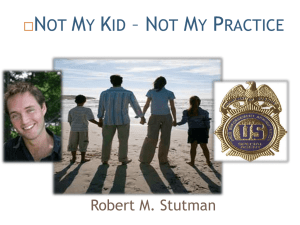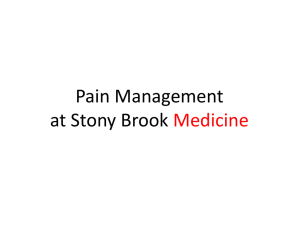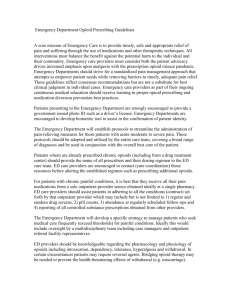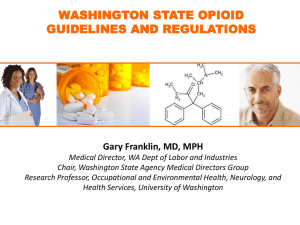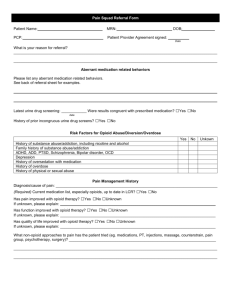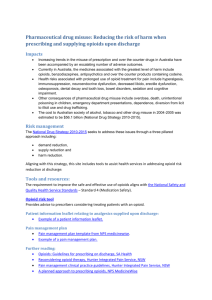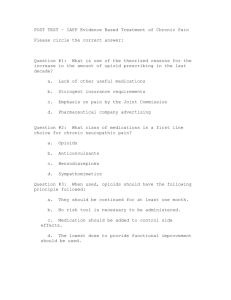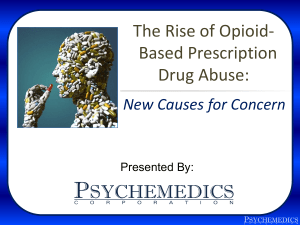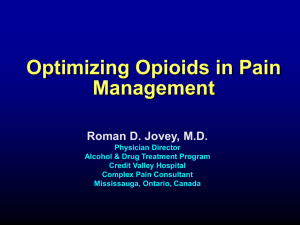Ohio ADF Statement Good morning, My name is Dr. Elizabeth Lottes
advertisement
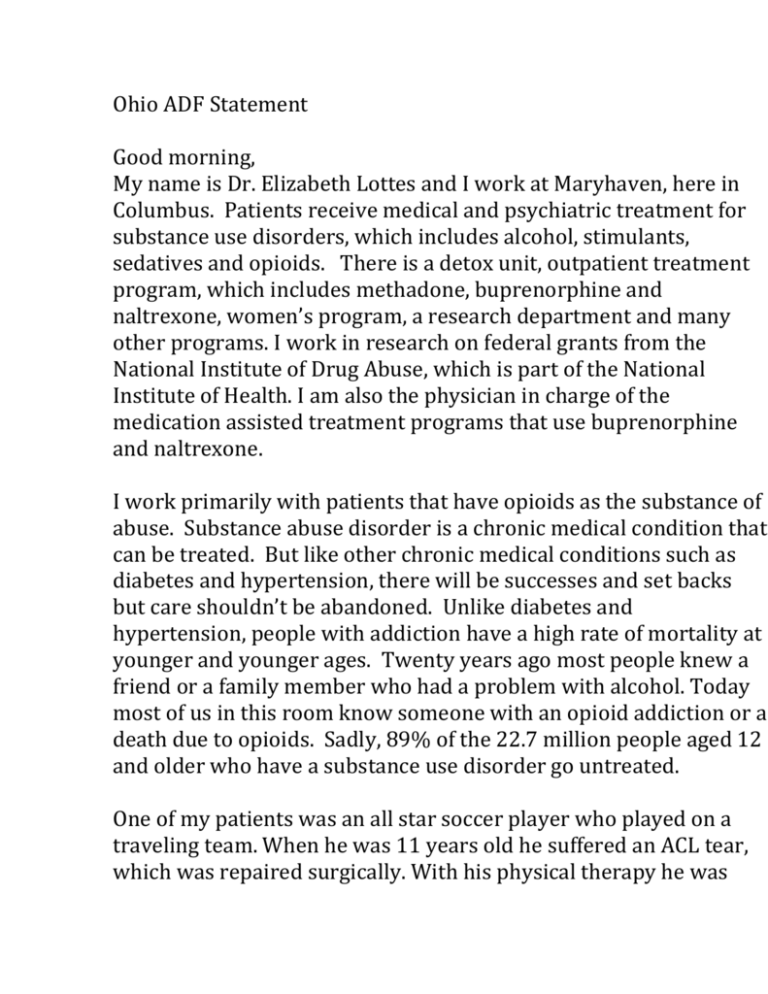
Ohio ADF Statement Good morning, My name is Dr. Elizabeth Lottes and I work at Maryhaven, here in Columbus. Patients receive medical and psychiatric treatment for substance use disorders, which includes alcohol, stimulants, sedatives and opioids. There is a detox unit, outpatient treatment program, which includes methadone, buprenorphine and naltrexone, women’s program, a research department and many other programs. I work in research on federal grants from the National Institute of Drug Abuse, which is part of the National Institute of Health. I am also the physician in charge of the medication assisted treatment programs that use buprenorphine and naltrexone. I work primarily with patients that have opioids as the substance of abuse. Substance abuse disorder is a chronic medical condition that can be treated. But like other chronic medical conditions such as diabetes and hypertension, there will be successes and set backs but care shouldn’t be abandoned. Unlike diabetes and hypertension, people with addiction have a high rate of mortality at younger and younger ages. Twenty years ago most people knew a friend or a family member who had a problem with alcohol. Today most of us in this room know someone with an opioid addiction or a death due to opioids. Sadly, 89% of the 22.7 million people aged 12 and older who have a substance use disorder go untreated. One of my patients was an all star soccer player who played on a traveling team. When he was 11 years old he suffered an ACL tear, which was repaired surgically. With his physical therapy he was started on Vicodin as needed for pain. Unfortunately he became addicted to the Vicodin and began stealing to buy more opioids. In one year, at the age of 12 he began shooting heroin and continued for 6 more years. I saw him during his senior year for detox, which I would like to say was successful but it wasn’t. He relapsed back to heroin and died of an overdose. The majority of the patients I treat are heroin addicts but greater than 95% of them started on prescription opioids. There are also the patients who have used only prescription pain medicine and are now seeking treatment. The vast majority of patients started using prescription pain medicine in their teens. The cost of prescription opioids on the street is $1 per milligram. So if a person is using 10 Vicodin 10mg tablets a day, they now have $100 day habit. Many of the people still on prescription opioids are using upwards of $300 a day. How do people get started? Most tell me that when they were 11-12 years old they started stealing pills from medicine cabinets. All agree that it is far easier to get pills than alcohol. People realize rather quickly, that depending on the route taken, that some will yield quicker and more potent euphoria. When taken orally the opioid will reach the brain in 20-30 minutes, inhaling the opioid will allow it to reach the brain in 3-5 minutes and injecting it will allow it hit the brain in 7-8 seconds. I have older patients, who recall when oxycontin hit the market and had no abuse deterrent formulation. The medicine was easily ground into a powder, heated and liquefied for a potent injection. Given the destruction that occurred in Southeast Ohio, pharmaceutical companies did change the formula so that Hillbilly Heroin was no longer injectable. Unfortunately it did not motivate all manufacturers to go farther with the abuse deterrent formulation. Patients have shared that shaving pills with a hose clamp yields a very fine powder that produces a good high when inhaled. This is the route almost all adolescents and young adults use for prescription opioid abuse. The current legislation accomplishes what was started with the reformulation of oxycontin and will further the lower the risk of abuse with inhalation with the new abuse deterrent formulation. The US Dept. of HHS/FDA issued a Guide for Abuse Deterrent Opioids : Evaluation and Labeling in April of this year. The FDA was moved to delineate exactly how opioids should be developed to resist known or expected routes of abuse. There will be costs and the legislation is forward thinking in addressing these issues with the insurance companies. When compared to the costs the opioid epidemic is costing the nation, it will be cost saving in the long run. It is time this technology was put into action to save lives. Of concern, is the recent approval by the FDA for use of oxycontin for children aged 11-17 year-olds. Pain control is vital for all patients of all ages that suffer. By enlarging the window for patients able to get oxycontin , it will be even more important to ensure the safety of all. I also work in hospice and pain control is a main goal, so I do not believe that restricting opioids is the solution. However it will increase the safety of effective pain management if abuse deterrent formulations are used. In 2013, 6.5 million people 12 years of age or older reported using prescription medications for nonmedical reasons. Another aspect of this legislation is very vital concerns the Press Ganey item that asks patients if their pain was adequately treated. As a physician, I am the first to admit that when I started in medicine a patient’s pain was not always adequately addressed. But the pendulum has swung too far from that point. Emergency Room physicians are compensated based on the Press Ganey scores so they often feel caught between two forces. One side is to write appropriate and adequate pain medications while the other side exhorts to prescribe for almost everyone so that the hospital gets full compensation for services. It is currently an untenable situation for patients, physicians, hospitals and insurers. It has gotten so out of control that patients that I am treating in an opioid treatment program with medications such as buprenorphine or naltrexone are fearful of going to the hospital. Whether it be for a skin abscess or an infected tooth, patients in current treatment who tell the physician that they can’t take opioids because of their sobriety- will always be given a script of an opioid prior to discharge. To underestimate the power of these patient satisfaction surveys and their impact on payment is extremely short sighted by society. By removing Question #17 , it would relieve the burden of many ER physicians to give every patient an opioid. Finally as a addiction medicine physician, I would encourage all members to consider the impact opioids are having on citizens of Ohio and the path of destruction that continues to run through every city, suburb, and county. No physician wants to lose any patient to a disease that can be treated. Just as parents and communities are ill equipped to handle the mounting overdose deaths that striking younger and younger people. The disease of addiction knows no zip code. Please help make medical care safer by passing this Abuse Deterrent Formula legislation. Thank you for your time and attention.
